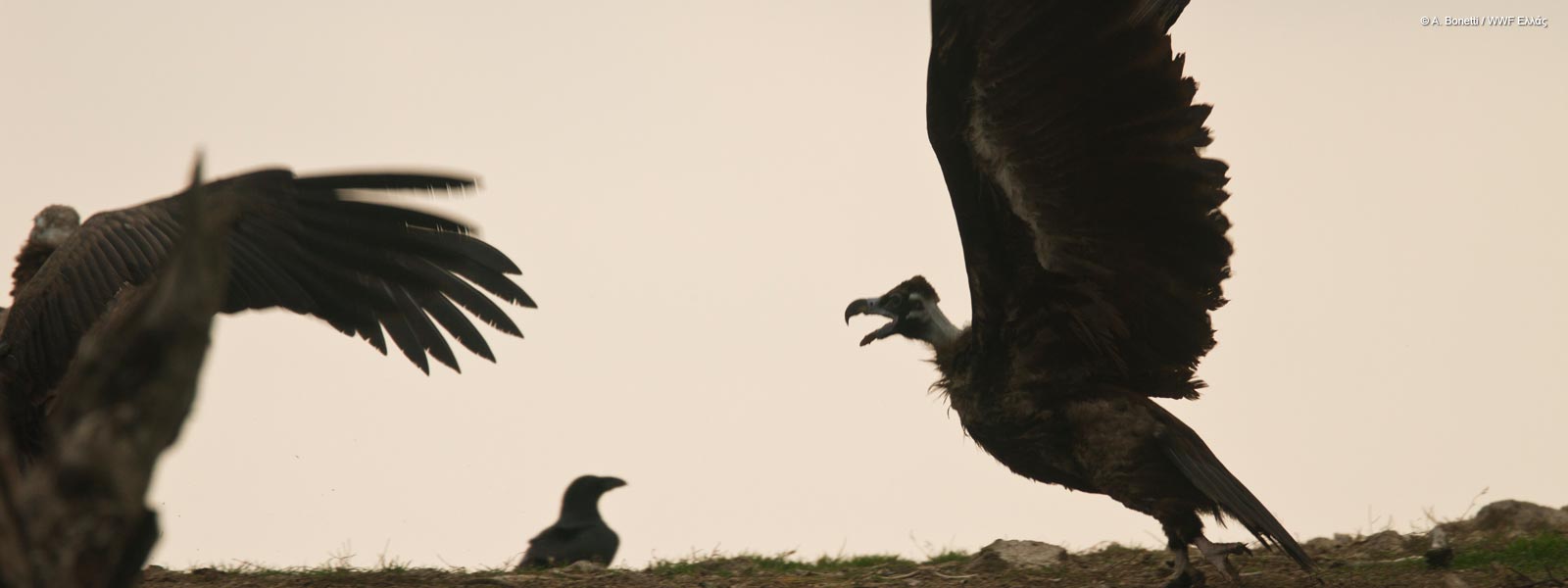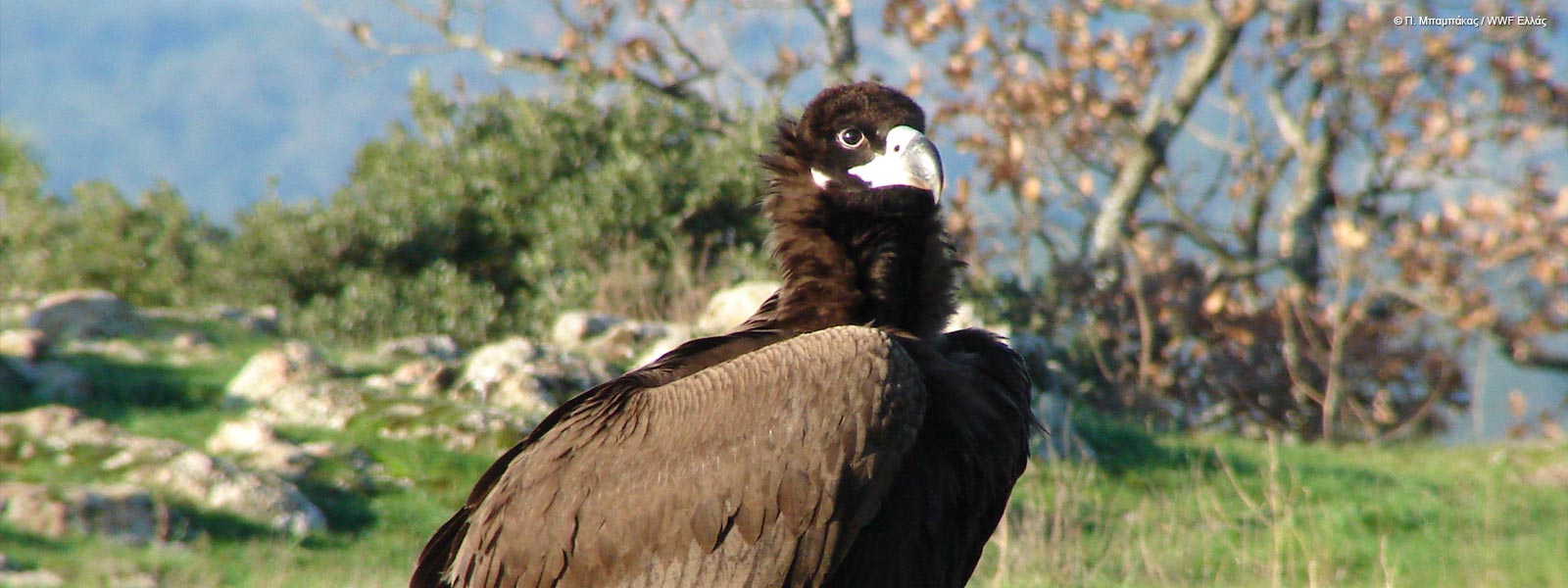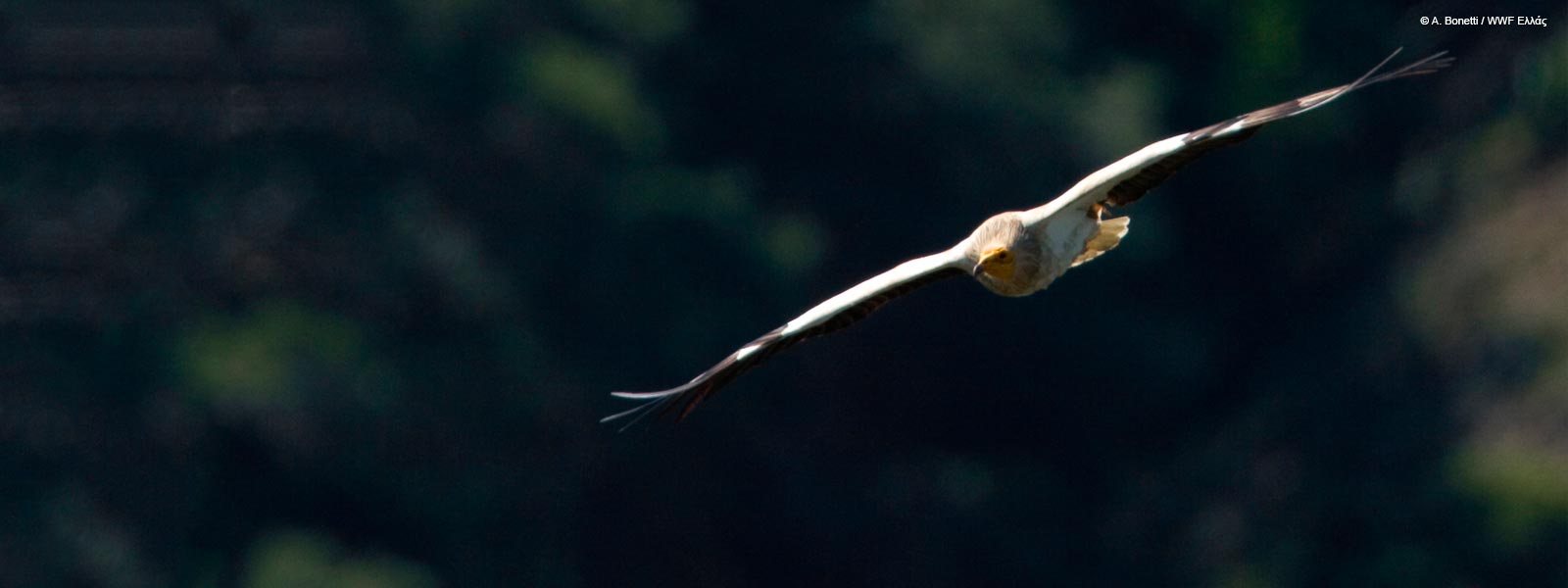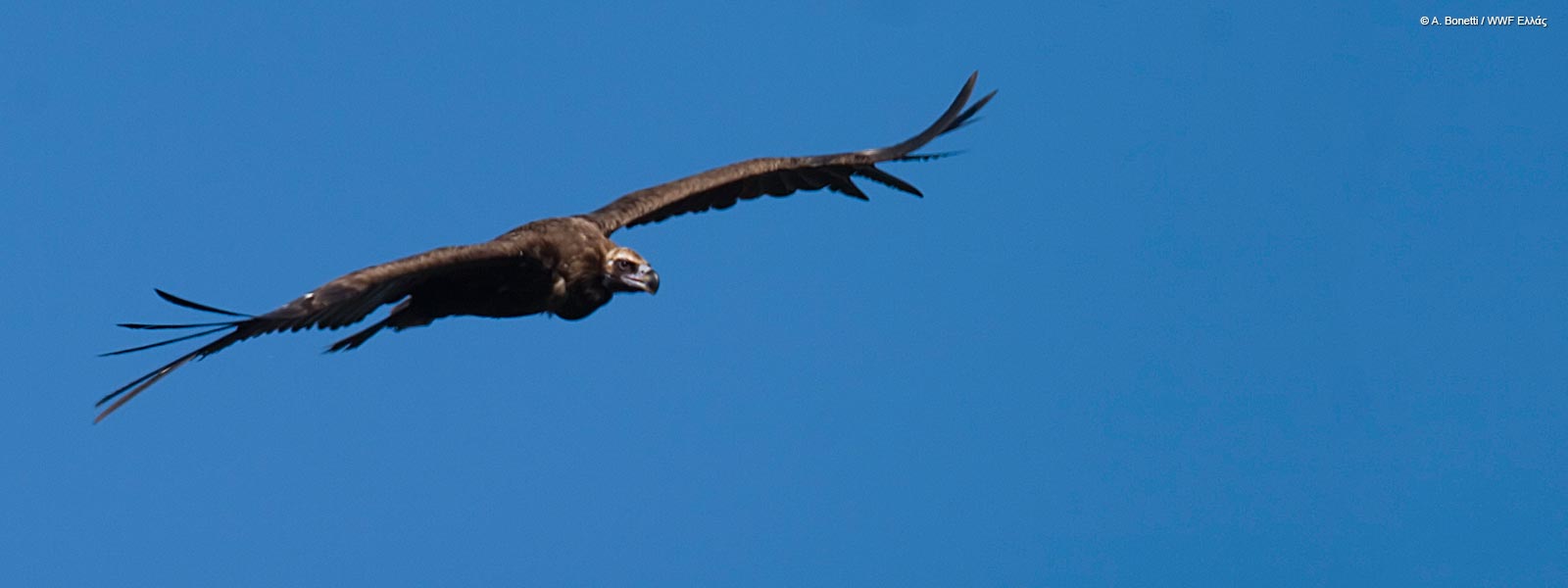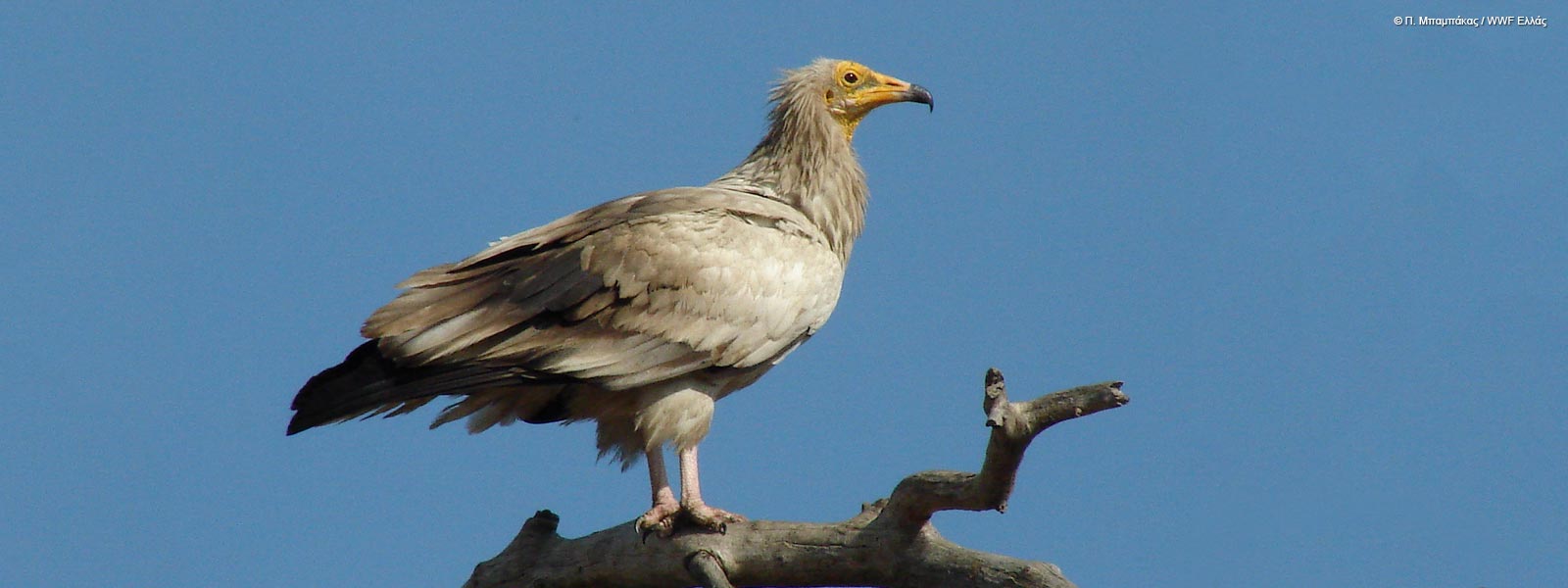Building on the strong foundation of our continuous presence in the area of Dadia in Evros, we broaden the scope of our work for the area’s vultures. Apart from black vultures, for which Dadia is the last breeding place in the Balkans, we turn our focus on the globally threatened Egyptian vultures, which use Dadia as a summer refuge, traveling there from Africa, where they winter.
BLACK VULTURES
Although black vulture population was thriving in Greece until the early 1950s, it shrunk dramatically thereafter, and, by the 1980s, the species would only reproduce in two places: Mount Olympus and the Dadia-Lefkimi-Soufli National Park in Evros. Nowadays, the National Park is home to the only breeding black vulture population throughout the Balkan Peninsula.
WWF Greece has worked in this ecologically sensitive area since 1980, and our permanent scientific team took up residence there in 1992. As a result of our work and cooperation with local institutions (Forest Authority of Soufli, Municipality of Soufli, Regional Unit of Evros and Management Body of the Dadia-Lefkimi-Soufli National Park), the black vulture population increased from 16 pairs and 55 individuals in 1992 to 28 pairs and 90–100 individuals in the past five years.
The Life of the Black Vulture
The black vulture (Aegypius monachus) is one of the threatened species of the Greek fauna and, according to The Red Data Book of Threatened Animals of Greece (Athens, 2009), an endangered one. In the beginning of January, black vulture pairs commence their mating displays and build their nests together on treetops.
A nest can be as wide as 2 meters in diameter and up to 1 meter high. The pair shares the responsibility of incubating their only egg for 50–55 days, between February and March, and of raising the hatchling. The arrival of the new family member brings on new responsibilities for the parents, who feed their young from May and for about 3.5 months, until it is ready to fly off the nest. Black vultures reach adulthood and maturity at the age of 5–6. Until then, they travel through the surrounding regions, getting to know all food resources outside the limits of the Dadia National Park, all the way to the Nestos River and neighboring Bulgaria.
Life under Threat
Poisoned baits pose one of the main threats to the survival of black vultures and the other raptors of the area. They are still used against large and small carnivores, such as wolves, jackals, foxes, weasels and badgers, and birds, particularly corvines, that is, wildlife species that in the past were hunted down as harmful to agricultural production.
Another factor that led to the depletion of black vulture population in the Greek countryside was the lack of food due to the shift of animal husbandry practices from free range to confinement. Moreover, the installation of wind farms in preying territories is another new yet substantiated (in Greek) cause of black vulture fatalities due to collisions with wind turbines. Electrocution by medium voltage power lines has also been verified.
The life We Protect
Our work in the area has already contributed to the significant growth of black vulture population, and our permanent scientific team is involved in all aspects of the species’ protection.
We have been monitoring the breeding activity and success of this unique bird of prey since 1994 and have implemented a ringing program and radio and satellite telemetry systems to monitor black vulture population and movements. Our findings contribute to making proper management decisions regarding the area.
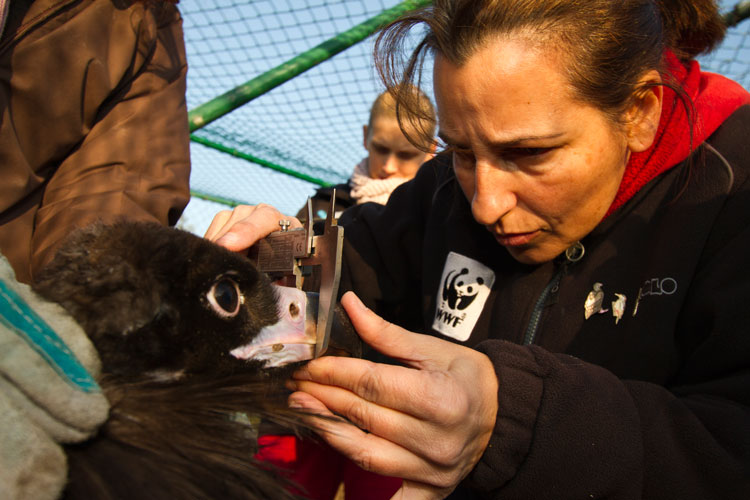
Dora Skartsi had a face to face with Iason, the black vulture that we ringed in the fall of 2013.
© A. Bonetti / WWF Greece
Carried out in the Dadia Forest by the Regional Unit of Evros for 25 years, supplementary feeding has clearly been beneficial to the conservation of this specific Balkan population. In this way, we contribute to the survival of young birds, helping them find safe food during the first months of their life after leaving the nest, and to that of the entire population, providing supplemental food during the difficult winter months, when food sources are reduced as has been demonstrated by the longitudinal data that we gather through vulture counts in the feeding area in Dadia.
In cooperation with corresponding Bulgarian institutions, we carry out joint monitoring activities and work to exchange and share know-how and experiences.
EGYPTIAN VULTURES
The Life of the Egyptian Vulture
The smallest of the four European vulture species, the Egyptian vulture, is a unique traveler roaming the skies of Africa and the Mediterranean. The migratory Egyptian vultures choose our neighborhood to perpetuate the species and Africa to winter in its warmer climate. A significant population can be found in the Balkans, and Dadia—as well as the wider area of Thrace—is yet again proven particularly hospitable to European vultures.
Specifically, the Egyptian vultures of the Balkan population that nest in Greece, Bulgaria, FYROM and Albania move through Turkey, Syria, Lebanon, Israel and Egypt to end up mainly in Chad or Sudan in Africa or fly across Greece and over the sea between Crete and Africa to reach their destination.
For Egyptian vultures, family comes first! They lay between 1 and 3 eggs whose care is equally undertaken by both parents. Their food is very much like that of the other vultures, though they do have a tendency to enrich their diet with hedgehogs, tortoises, lizards and insects. Rock cavities near areas with intense animal husbandry are their favorite nesting sites.
Life under Threat
This unique vulture is nowadays a globally endangered species, and its population is one of the most rapidly decreasing in the world. Half of Europe’s Egyptian vultures have been lost during the past thirty years. In Greece, the species is considered critically endangered. With 70 pairs recorded in 2000, only 15 were recorded in 2012, mainly in Thrace and Meteora. Having conserved 5 pairs, the forest of Dadia holds first place again and proves once more that conservation activities have had a beneficial effect on a species whose population has been collapsing throughout Greece year after year.
The main causes of population loss in Greece are: poisoning due to the consumption of poisoned animals, electrocution, disturbance in nesting sites and the depletion of available food resources, particularly after most dumpsites in Greece were shut down, the free disposal of slaughterhouse waste was banned and waste management turned to neutralization practices.
The life We Protect
The decline of the Balkan population instigated an interstate program in Bulgaria and Greece carried out with European funding (LIFE Nature NAT/BG/000152) and co-funded by the A.G. Leventis Foundation. WWF Greece participates in the program, focusing on a research and conservation area that ranges from the forest of Dadia to the Kompsatos River, including the rest of the mountainous area of the prefectures of Evros and Rodopi.
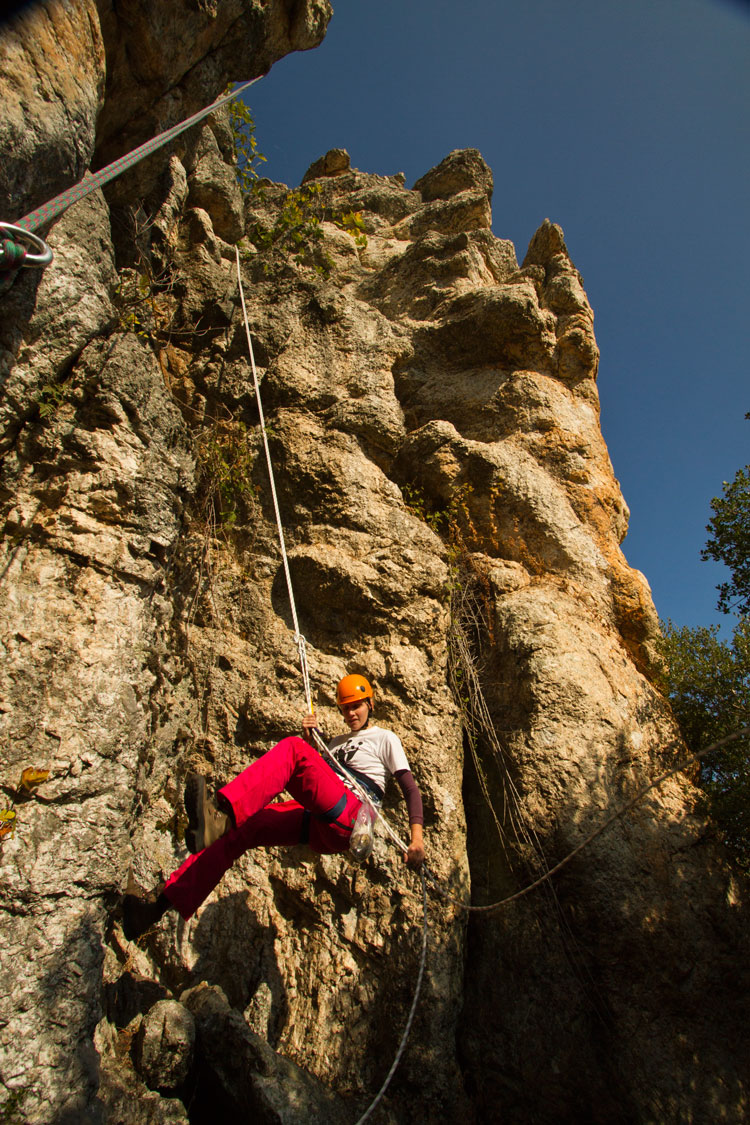
© A. Bonetti / WWF Greece
Through this program, which provides us daily with new information and yields significant results in conservation, we record the migration routes of the species and obtain a clearer picture of the threats that are present in each country. In breeding sites, like Dadia, we focus on conservation activities and the indispensable awareness-raising activities in local communities to help them realize that the species’ conservation is beneficial to us all.
Safeguarding the few remaining nests, providing supplementary food, insulating power line towers, countering the problem of poisoned baits and disseminating information among the area’s residents are the initiatives that we undertake to conserve the existing pairs and allow their number to grow enough to reverse the collapsing course of the species.
With a country that offers natural conditions so favorable to the survival of unique species, such as the Egyptian vulture, how can we be inhospitable or stand aloof?
Share this




